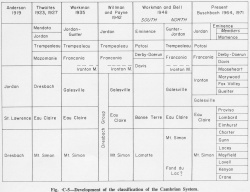Historical:Ironton Sandstone
Lithostratigraphy: Knox Dolomite Megagroup >>Ironton Sandstone
Chronostratigraphy: Paleozoic Erathem >>Cambrian System >>Croixan Series >>Franconian Stage
Allostratigraphy: Sauk Sequence
Author
T. C. Buschbach
Name Origin
The Ironton Sandstone is named for Ironton, Sauk County, Wisconsin, where it consists of a few feet of hard, calcareous, coarse-grained sandstone classified as the basal member of the Franconia Formation.
Correlation
In Illinois, a much thicker coarse-grained sandstone at this position, previously included in the Dresbach Sandstone, was correlated with the Ironton Member of the Franconia, but it later was made a separate formation (fig. Є-5). Today, it is correlated with the lower part of the Davis Formation in Missouri.
Extent and Thickness
The Ironton Sandstone, like the Galesville (fig. Є-10), occurs throughout the northern half of Illinois and is not exposed. The Ironton is commonly 50-100 feet thick, but it is somewhat thinner in northwestern Illinois. The Ironton Sandstone is conformable with the formations above and below. It is also present in Minnesota, Michigan, and Indiana but is an undifferentiated part of the Galesville Sandstone in those areas.
Stratigraphic Position
The Ironton Sandstone (Thwaites, 1923, p. 93-94) is a relatively coarse-grained sandstone overlying the finer grained Galesville Sandstone and underlying the glauconitic, argillaceous sandstone of the Franconia Formation.
Description
Near the northern boundary of Illinois, the Ironton is medium-grained, poorly sorted, white sandstone with coarse-grained beds near the top. It generally contains light pinkish buff dolomite as a cementing material and as pebbles in conglomeratic layers (fig. Є-1D). Farther south it is more dolomitic. At its southern margin it grades into sandy dolomite, and, like the Galesville Sandstone, is terminated by vertical cutoff. The Ironton Sandstone is coarser grained than sandstones in the formations above and below, and it lacks the clay and glauconite commonly associated with the overlying Franconia (Buschbach, 1964). Variations in grain size and dolomite content serve to divide the Ironton into four members: the Buelter Member (at the base) is medium-grained sandstone; the Fox Valley Member is medium- to coarse-grained dolomitic sandstone; the Marywood Member is finer grained and less dolomitic sandstone; and the Mooseheart Member (at the top) is medium- to coarse-grained dolomitic sandstone. The petrographic characteristics of the Ironton Sandstone have been described by Emrich (1966).
Fossils
In the outcrop region in Wisconsin, the Ironton is fossiliferous and contains the Elvinia Zone, which marks the base of the Franconian Stage. Worm borings are common in some of the dolomitic beds, which are called wormstone beds.
References
BUSCHBACH, T. C., 1964, Cambrian and Ordovician strata of northeastern Illinois: Illinois State Geological Survey Report of Investigations 218, 90 p.
EMRICH, G. H., 1966, Ironton and Galesville (Cambrian) Sandstones in Illinois and adjacent areas: Illinois State Geological Survey Circular 403, 55 p.
THWAITES, F. T., 1923, Paleozoic rocks found in deep wells in Wisconsin and northern Illinois: Journal of Geology, v. 31, p. 529-555.
ISGS Codes
| Stratigraphic Code | Geo Unit Designation |
|---|---|



